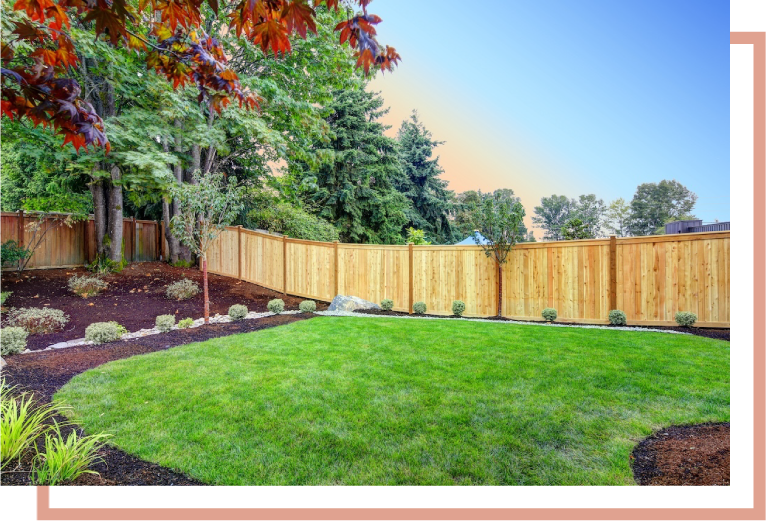It may seem like an impossible, or at least expensive, task to build a fence on your sloped yard, but building a fence on a hill fortunately doesn’t mean that you need to level your yard. There are other methods of building a fence on slopes that are much less expensive and require less work. You can have a fence that’s durable, affordable, and attractive without any of the hassle.
Table of Contents
ToggleLet’s discuss the different methods of building fences on a slope, how to install a backyard fence on a slope, and what you can do to add more privacy to your fence on a sloped yard.
Ideas for Building a Fence on a Slope
There are two main strategies for building a fence on a slope.
Racked Fences
Racking is the most popular way to adjust your fence to slopes in your yard. Racked fences follow the slopes of the ground, leaving no gaps between the bottom of the rail and the ground. This method allows for a uniform, seamless appearance.
Stepped Fences
Stepped fences are a great alternative to racked fences if your yard has steeper grades. A stepping fence does not follow the shape of the land, creating an uneven rail line that resembles stairs. This type of fence will leave triangular gaps between the bottom rail and the ground.

Backyard Fence on a Slope
How to Install Racked Fences
Measure and Mark Your Fence Line
- Mark the two ends of your fence line with wooden stakes, and use the mason line to attach them.
- Measure the distance between your proposed pots and mark it on the string with tape. The measurements will often land between five and eight feet, but this will depend on whether you’re using a premade fence panel.
- Attach a plumb bob to each part of your string above where the posts will go. Mark the spot on the ground just above the plumb bob with a utility flag or spray paint.
Install Your Posts
- Measure a hole three times your post’s diameter and as deep as at least a third of the post’s height.
- Drive a post-hole digger lightly into the ground to remove the earth. Work slowly until you’ve reached the correct depth and width. Then, follow the length of your string and dig each post hole before moving on to the next step.
- With assistance, place the first post in the whole and check that it’s plumb. A standard level should guarantee that your post is completely upright.
- Fill the base of the post hole with three inches of soil and gravel to promote groundwater drainage.
- Mix your concrete and fill the hole to just below the base of the hole. Let the concrete set, bracing the post in the right position with bricks if it needs to be left overnight.
Attach Your Rails or Panels
- Attach the mason line to the top of the two fence posts. You’ll need this angle to match the slope of the hill for each rail. Rails typically sit approximately eight inches off the ground and eight inches from the top of your posts.
- Matching the slope of the mason line, attach both rails to the posts with two three-inch masonry screws.
Attach Your Pickets
- Measure at least two inches from the ground to mark where the first rail sits. The two-inch space allows water to flow under your fence.
- Hold the first picket flush with the post and check that it’s plumb. Measure the distance between the masonry line, or the top of the top rail, and the top of your picket.
- Secure your picket to your rails with brand nails and a pneumatic brand nail gun. As you move down the hill, the top of each picket should always be the same distance from the masonry line or the top of the rail. This will guarantee that you maintain the same even slope created by the rail.
How to Install Stepped Fences
Measure and Mark Your Fence Line
- When measuring your stepped fence, place two tall stakes in the ground between the top and bottom of one side of your fence. This time, string a mason line between the top of the two stakes and level it.
- Measure the space between the bottom of the string and the ground to check the drop of the slope in that part of the hill.
Install Your Posts
- Measure a hole three times your post’s diameter and as deep as at least a third of the post’s height.
- Drive a post-hole digger lightly into the ground to remove the earth. Work slowly until you’ve reached the correct depth and width. Then, follow the length of your string and dig each post hole before moving on to the next step.
- With assistance, place the first post in the whole and check that it’s plumb. A standard level should guarantee that your post is completely upright.
- Fill the base of the post hole with three inches of soil and gravel to promote groundwater drainage.
- Mix your concrete and fill the hole to just below the base of the hole. Let the concrete set, bracing the post in the right position with bricks if it needs to be left overnight.
Once you determine the number of posts and fencing sections, divide the total drop of your fence by the number of sections to determine the drop for each section.
Measure for the Rails
- Use the mason line and tie it to your first post according to your dorp measurement.
- String the line in your next post and make sure that the line is level. Mark the place where the line connects with this post. The line you just made is the new top of the second post. Cut off the top of the post where you made your mark.
- Repeat the process between your second and third posts. Measure down four inches from the top of the second post and string the line to the third. Cut and continue.
Attach Your Panels, Rails, or Pickets
- Use your mason line to mark the space between the two posts for the top rail. In most cases, this is a design between seven and eight inches down from the top, but it varies depending on your design.
- Secure the level rail between two posts with three-inch masonry screws.
- Attach your pickets between the two posts with brand nails.
If you’d rather leave it to the pros, check out our fence installation services to ensure your sloped fence is built right the first time.
Privacy Fence on a Slope
In order to build a privacy fence, the gaps between the slats in your fence, as well as underneath, should be filled in. You can use a number of methods to do this.
If you’re looking for more privacy, you can try:
- Adding more slates
- Using vinyl woven straps
- Lining the fence with hedges
- Building a raised garden
- Using Symmetrical hedges
- Using Chain links
- Using Wooden blocks
- Using Cement blocks
Call Northwest Cedar Fence Today
If you’re interested in building a fence on your sloped yard or you want to upgrade your fence, our dependable team at Northwest Cedar Fence Company will be with you every step of the way. We are a fourth-generation company that is now the industry leader in premier Illinois & Wisconsin fencing, so you can rest knowing that our work and our results are always exceptional. We provide top-quality fences in cedar, aluminum, and vinyl.
Start the journey to a durable, attractive fence on your sloped yard by calling us at (815) 706-3732 or schedule an appointment online.




